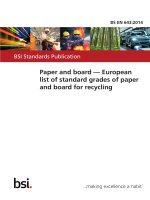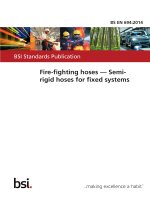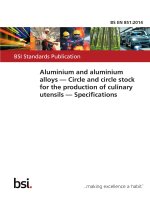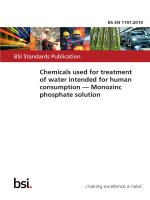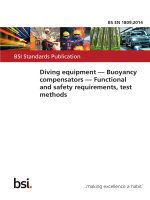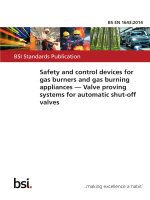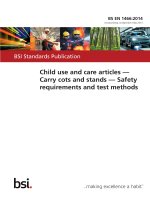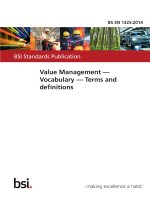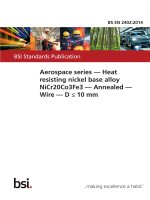Bsi bs en 00453 2014
Bạn đang xem bản rút gọn của tài liệu. Xem và tải ngay bản đầy đủ của tài liệu tại đây (2.03 MB, 50 trang )
BS EN 453:2014
BSI Standards Publication
Food processing machinery —
Dough mixers — Safety and
hygiene requirements
BS EN 453:2014
BRITISH STANDARD
National foreword
This British Standard is the UK implementation of EN 453:2014. It
supersedes BS EN 453:2000+A1:2009 which is withdrawn.
The UK participation in its preparation was entrusted to Technical
Committee MCE/3/5, Food industry machines.
A list of organizations represented on this committee can be
obtained on request to its secretary.
This publication does not purport to include all the necessary
provisions of a contract. Users are responsible for its correct
application.
© The British Standards Institution 2014.
Published by BSI Standards Limited 2014
ISBN 978 0 580 76458 5
ICS 67.260
Compliance with a British Standard cannot confer immunity from
legal obligations.
This British Standard was published under the authority of the
Standards Policy and Strategy Committee on 30 November 2014.
Amendments issued since publication
Date
Text affected
BS EN 453:2014
EN 453
EUROPEAN STANDARD
NORME EUROPÉENNE
EUROPÄISCHE NORM
October 2014
ICS 67.260
Supersedes EN 453:2000+A1:2009
English Version
Food processing machinery - Dough mixers - Safety and
hygiene requirements
Machines pour les produits alimentaires - Pétrins Prescriptions relatives à la sécurité et l'hygiène
Nahrungsmittelmaschinen - Teigknetmaschinen Sicherheits- und Hygieneanforderungen
This European Standard was approved by CEN on 6 September 2014.
CEN members are bound to comply with the CEN/CENELEC Internal Regulations which stipulate the conditions for giving this European
Standard the status of a national standard without any alteration. Up-to-date lists and bibliographical references concerning such national
standards may be obtained on application to the CEN-CENELEC Management Centre or to any CEN member.
This European Standard exists in three official versions (English, French, German). A version in any other language made by translation
under the responsibility of a CEN member into its own language and notified to the CEN-CENELEC Management Centre has the same
status as the official versions.
CEN members are the national standards bodies of Austria, Belgium, Bulgaria, Croatia, Cyprus, Czech Republic, Denmark, Estonia,
Finland, Former Yugoslav Republic of Macedonia, France, Germany, Greece, Hungary, Iceland, Ireland, Italy, Latvia, Lithuania,
Luxembourg, Malta, Netherlands, Norway, Poland, Portugal, Romania, Slovakia, Slovenia, Spain, Sweden, Switzerland, Turkey and United
Kingdom.
EUROPEAN COMMITTEE FOR STANDARDIZATION
COMITÉ EUROPÉEN DE NORMALISATION
EUROPÄISCHES KOMITEE FÜR NORMUNG
CEN-CENELEC Management Centre: Avenue Marnix 17, B-1000 Brussels
© 2014 CEN
All rights of exploitation in any form and by any means reserved
worldwide for CEN national Members.
Ref. No. EN 453:2014 E
BS EN 453:2014
EN 453:2014 (E)
Contents
Page
Foreword ..............................................................................................................................................................4
Introduction .........................................................................................................................................................5
1
Scope ......................................................................................................................................................6
2
Normative references ............................................................................................................................6
3
3.1
3.2
Terms, definitions and description ......................................................................................................7
Terms and definitions ...........................................................................................................................7
Description .............................................................................................................................................7
4
List of significant hazards ....................................................................................................................8
5
5.1
5.2
5.2.1
5.2.2
5.2.3
5.2.4
5.2.5
5.2.6
5.2.7
5.2.8
5.3
5.3.1
5.3.2
5.3.3
5.3.4
5.3.5
5.4
5.5
5.6
5.7
5.8
5.9
Safety and hygiene requirements and/or protective measures ........................................................9
General ....................................................................................................................................................9
Mechanical hazards ............................................................................................................................ 10
General ................................................................................................................................................. 10
Zone 1 – Volume covered by the movement of the kneading tools .............................................. 10
Zone 2 – Space between bowl and frame ......................................................................................... 11
Zone 3 – Bowl driving mechanism .................................................................................................... 12
Zone 4 – Kneading tool-holder driving, positioning and adjusting mechanism .......................... 12
Loss of stability................................................................................................................................... 13
Guide rollers and bowl ....................................................................................................................... 13
Power operated guards and bowl ..................................................................................................... 13
Electrical hazards ............................................................................................................................... 13
General ................................................................................................................................................. 13
Safety requirements related to electromagnetic phenomena ........................................................ 13
Protection against electric shock ..................................................................................................... 13
Power circuits ..................................................................................................................................... 14
Protection against earth faults in control circuits ........................................................................... 14
Motor enclosures ................................................................................................................................ 14
Emergency stop .................................................................................................................................. 14
Noise reduction ................................................................................................................................... 14
Protection against dust emission ..................................................................................................... 14
Hygiene requirements ........................................................................................................................ 14
Hazards generated by neglecting ergonomic principles ................................................................ 16
6
Verification of safety and hygiene requirements and/or measures .............................................. 17
7
7.1
7.2
7.3
Information for use ............................................................................................................................. 18
General ................................................................................................................................................. 18
Instruction handbook ......................................................................................................................... 18
Marking ................................................................................................................................................ 20
Annex
A.1
A.2
A.3
A.4
A.5
A.6
A.7
A.8
A (normative) Noise test code for dough mixers – Grade 2 of accuracy ....................................... 21
Installation and mounting conditions ............................................................................................... 21
Operating conditions .......................................................................................................................... 21
Measurements ..................................................................................................................................... 21
Emission sound pressure level determination ................................................................................ 21
Sound power level determination ..................................................................................................... 22
Measurement uncertainties ............................................................................................................... 22
Information to be recorded ................................................................................................................ 22
Information to be reported ................................................................................................................. 23
2
BS EN 453:2014
EN 453:2014 (E)
A.9
Declaration and verification of noise emission values ................................................................... 23
Annex B (normative) Principles of design to ensure the cleanability of dough mixers ............................ 24
B.1
Terms and definitions ......................................................................................................................... 24
B.2
Materials of construction .................................................................................................................... 24
B.3
Design ................................................................................................................................................... 25
Annex C (informative) Method of measuring dust ......................................................................................... 43
C.1
Purpose of the test .............................................................................................................................. 43
C.2
Principle of the tests ........................................................................................................................... 43
C.3
Operating conditions .......................................................................................................................... 43
Bibliography ...................................................................................................................................................... 45
3
BS EN 453:2014
EN 453:2014 (E)
Foreword
This document (EN 453:2014) has been prepared by Technical Committee CEN/TC 153 “Machinery intended
for use with foodstuffs and feed”, the secretariat of which is held by DIN.
This European Standard shall be given the status of a national standard, either by publication of an identical
text or by endorsement, at the latest by April 2015 and conflicting national standards shall be withdrawn at the
latest by April 2015.
Attention is drawn to the possibility that some of the elements of this document may be the subject of patent
rights. CEN [and/or CENELEC] shall not be held responsible for identifying any or all such patent rights.
This document supersedes EN 453:2000+A1:2009.
This document has been prepared under a mandate given to CEN by the European Commission and the
European Free Trade Association, and supports essential requirements of EU Directive 2006/42/EC.
For relationship with EU Directive 2006/42/EC, see informative Annex ZA, which is an integral part of this
document.
Significant changes:
The significant changes with respect to the previous edition EN 453:2000+A1:2009 are listed below:
—
solid guard to protect against dust emission was added;
—
table of verification of safety and hygiene requirements was completely revised.
According to the CEN-CENELEC Internal Regulations, the national standards organizations of the following
countries are bound to implement this European Standard: Austria, Belgium, Bulgaria, Croatia, Cyprus, Czech
Republic, Denmark, Estonia, Finland, Former Yugoslav Republic of Macedonia, France, Germany, Greece,
Hungary, Iceland, Ireland, Italy, Latvia, Lithuania, Luxembourg, Malta, Netherlands, Norway, Poland, Portugal,
Romania, Slovakia, Slovenia, Spain, Sweden, Switzerland, Turkey and the United Kingdom.
4
BS EN 453:2014
EN 453:2014 (E)
Introduction
This document is a type C standard as stated in EN ISO 12100.
The machinery concerned and the extent to which hazards, hazardous situations and events are covered are
indicated in the scope of this European Standard.
When provisions of this type C standard are different from those which are stated in type A or B standards, the
provisions of this type C standard take precedence over the provisions of the other standards, for machines
that have been designed and built according to the provisions of this type C standard.
5
BS EN 453:2014
EN 453:2014 (E)
1
Scope
1.1 This European Standard specifies safety and hygiene requirements for the design and manufacture of
dough mixers with rotating bowls of capacity greater than or equal to 5 L 1) and less than or equal to 500 L.
These dough mixers are used separately or in a line in the food industry and shops (pastry-making, bakeries,
confectionery, etc.) for manufacturing of dough by mixing flour, water and other ingredients. These machines
can be fed by hand or mechanically.
These machines are sometimes used in other industries (e.g. pharmaceutical industry, chemical industry,
printing), but hazards related to these uses are not dealt with in this standard.
This European Standard deals with all significant hazards, hazardous situations and events relevant to the
transport, installation, adjustment, operation, cleaning, maintenance, dismantling, disassembling and
scrapping of dough mixers, when they are used as intended and under the conditions of misuse which are
reasonably foreseeable by the manufacturer (see Clause 4).
1.2
This European Standard does not deal with the following machines:
—
planetary mixers (see EN 454);
—
continuously fed machines;
—
mixers with stationary vertical bowls;
—
experimental and testing machines under development by the manufacturer;
—
domestic appliances;
—
automatic loading and unloading devices.
1.3 This European Standard is not applicable to machines which are manufactured before its date of
publication as a European Standard.
2
Normative references
The following documents, in whole or in part, are normatively referenced in this document and are
indispensable for its application. For dated references, only the edition cited applies. For undated references,
the latest edition of the referenced document (including any amendments) applies.
EN 614-1:2006+A1:2009, Safety of machinery ― Ergonomic design principles ― Part 1: Terminology and
general principles
EN 1672-2:2005+A1:2009, Food processing machinery ― Basic concepts ― Part 2: Hygiene requirements
EN 60204-1:2006, Safety of machinery ― Electrical equipment of machines ― Part 1: General requirements
(IEC 60204-1:2005, modified)
EN 60529, Degrees of protection provided by enclosures (IP Code) (IEC 60529)
1)
6
Below 5 L, EN 60335-1 and EN 60335-2 are applicable.
BS EN 453:2014
EN 453:2014 (E)
EN 61000-6-1, Electromagnetic compatibility (EMC) ― Part 6-1: Generic standards ― Immunity for
residential, commercial and light-industrial environments (IEC 61000-6-1)
EN ISO 3743-1, Acoustics ― Determination of sound power levels and sound energy levels of noise sources
using sound pressure ― Engineering methods for small movable sources in reverberant fields ― Part 1:
Comparison method for a hard-walled test room (ISO 3743-1)
EN ISO 3744:2010, Acoustics ― Determination of sound power levels and sound energy levels of noise
sources using sound pressure ― Engineering methods for an essentially free field over a reflecting plane
(ISO 3744:2010)
EN ISO 4287, Geometrical product specifications (GPS) ― Surface texture: Profile method ― Terms,
definitions and surface texture parameters (ISO 4287)
EN ISO 4871:2009, Acoustics ― Declaration and verification of noise emission values of machinery and
equipment (ISO 4871:1996)
EN ISO 11201:2010, Acoustics ― Noise emitted by machinery and equipment ― Determination of emission
sound pressure levels at a work station and at other specified positions in an essentially free field over a
reflecting plane with negligible environmental corrections (ISO 11201:2010)
EN ISO 12100:2010, Safety of machinery ― General principles for design ― Risk assessment and risk
reduction (ISO 12100:2010)
EN ISO 13849-1:2008, Safety of machinery ― Safety-related parts of control systems ― Part 1: General
principles for design (ISO 13849-1:2006)
EN ISO 13857:2008, Safety of machinery ― Safety distances to prevent hazard zones being reached by
upper and lower limbs (ISO 13857:2008)
EN ISO 14119:2013, Safety of machinery ― Interlocking devices associated with guards ― Principles for
design and selection (ISO 14119:2013)
3
3.1
Terms, definitions and description
Terms and definitions
For the purposes of this document, the terms and definitions given in EN ISO 12100:2010 apply.
3.2
Description
A dough mixer usually consists of:
—
a frame, supporting or containing the drive mechanism and control devices;
—
a bowl to contain the ingredients to be mixed. This bowl is driven either mechanically or through the
action of the kneading tool on the dough, may be removable, and may tilt;
—
one or more kneading tools on a vertical or inclined fixed axis or two special arms mixing the dough. In
some cases these devices can be raised to allow bowl or food removal.
7
BS EN 453:2014
EN 453:2014 (E)
4
List of significant hazards
This clause contains all the significant hazards, hazardous situations and events, identified by risk
assessment as significant for this type of machinery and which require measures to eliminate or reduce the
risk associated with the identified hazards (see Table 1).
The danger zones are given in Figure 1.
Table 1
Hazards, hazardous situations and
hazardous events
Clause/subclause in this
European Standard
Location or cause
Mechanical hazards (see Figure 3)
— crushing, shearing, trapping, and
impact
Zone 1: Volume covered by the
movement of the kneading tools
— drawing-in hazard and crushing
Zone 2: Space between bowl and
frame
— trapping and shearing
Zone 3: Bowl driving mechanism
— shearing, trapping, impact and
crushing
Zone 4: Kneading tool-holder driving,
positioning and adjusting mechanism
— drawing in or trapping
Zone 5: Guide rollers and bowl
— crushing
Zone 6: Powered guard and bowl
Electrical hazards
Electric shock from direct or indirect
contact with live components
5.2
Electromagnetic disturbance
5.3
5.3
IP degree
Motor enclosure
5.4
Stopping of the machine
No access to the normal OFF of the
machine
5.5
Hazards generated by noise
Hearing damage, accidents due to
interference
with
speech
communication and interference with
the perception of acoustic signals
5.6
7.2
Hazards generated by materials and
substances (inhalation of dust)
Flour dusters
Hazards generated by neglecting
hygienic design principles
e.g. contamination by microbial growth
or foreign materials
5.8
Hazards generated by neglecting
ergonomic principles
During
operation,
maintenance
5.9
8
5.7
cleaning
and
BS EN 453:2014
EN 453:2014 (E)
a)
b)
c)
Key
1
zone 1
volume covered by the movement of the kneading tools
2
zone 2
space between bowl and frame
3
zone 3
bowl driving mechanism
4
zone 4
kneading tool-holder driving, positioning and adjusting mechanism
5
zone 5
guide rollers and bowl
6
zone 6
powered guard and bowl
Figure 1 — Danger zones of a dough mixer
5
5.1
Safety and hygiene requirements and/or protective measures
General
Machinery shall comply with the safety requirements and/or protective measures of this clause.
9
BS EN 453:2014
EN 453:2014 (E)
In addition, the machine shall be designed according to the principles of EN ISO 12100 for relevant but not
significant hazards, which are not dealt with by this document.
5.2
5.2.1
Mechanical hazards
General
The safety related parts of the control system shall present at least a performance level “c” defined in
accordance with EN ISO 13849-1:2008.
When fixed guards, or parts of the machine acting as such, are not permanently fixed, e.g. by welding, their
fixing systems shall remain attached to the guards or to the machinery when the guards are removed.
5.2.2
Zone 1 – Volume covered by the movement of the kneading tools
NOTE
Usual conditions of use involve taking samples, adding some ingredients, scraping or taking away dough from
the inside of the bowl in order to be able to test its consistency or to measure its temperature. Accordingly, an opening is
necessary on the top of the bowl. This means that for these machines it is not possible to comply with the safety distances
given by EN ISO 13857. The strategy for selecting safety measures from EN ISO 12100 gives the following requirements
and/or measures.
5.2.2.1
Access from above shall be prevented while the tool is moving. This may be achieved by a
movable interlocking guard covering the top of the bowl. The bowl itself when in working position prevents
access from other directions.
If the bowl is removable the bowl and kneading tool drive mechanisms shall not be capable of operation when
the bowl is removed.
Guards may be, for example, hinged or move up and down vertically and be linked to suitable actuated
position detectors functioning in the positive mode in compliance with EN ISO 14119:2013, 5.4. Position
detectors themselves shall comply with EN ISO 14119:2013, 5.2 and 5.3.1, and any rotary or linear cams with
EN ISO 14119:2013, 5.3.2.
To minimize the possibility of defeat the interlocking mechanism shall be designed taking into account
EN ISO 14119:2013, Clause 7, for example by being located within the machine housing.
When there is an opening to enable the operator to see and take dough samples during the kneading process
it shall be entirely within the hatched area shown in Figure 2. This opening shall have a self-closing lid.
This hatched area shall be located on the bowl side opposite the kneading tool zone, and it shall have the
dimensional characteristics shown in Table 2. If the guard has holes, openings shall comply with
EN ISO 13857:2008, Table 4.
The measurements of the interlocking guard can be deduced from Table 2 in relation to Figure 2.
10
BS EN 453:2014
EN 453:2014 (E)
a)
b)
Key
(1)
volume covered by the kneading tool
a
distance between the internal rim of the bowl and the external part of the guard
b
horizontal distance between the external part of the guard and the nearest point of the danger zone, i.e. the volume
covered by the movement of the kneading tool(s)
c
distance between the bowl guard and the rotating bowl rim
d
distance between the upper rim of the bowl and the position of the outer edge of the guard when the interlocking
device is actuated
Figure 2 — Dimensions of the guard
Table 2 — Dimensions of the guard
Dimensions in millimetres
b
a
c
d
b ≤ 120
a=0
c ≤ 25
d < 25
120 < b ≤ 230
a ≤ 100
c ≤ 25
d < 50
b > 230
a ≤ 140
c ≤ 25
d < 75
5.2.2.2
In order to facilitate dough discharge from dough mixers with non-removable bowls, movement of
the kneading tool and bowl motions at low speed (speed of the tool ≤ 120 rpm) is permitted with the guard
opened, by operation of a hold-to-run control. This allows the operator to turn the bowl for unloading the bowl
in different positions.
5.2.2.3
Guard-actuated stopping devices shall stop the dough mixer with the bowl empty with 4 s of
opening the guard.
If this is not possible, opening of the guard shall be prevented until movement has ceased, for example by an
interlocking guard with guard locking (EN ISO 14119:2013, 5.7).
Release of any guard may be by a timer or operation of a stop detection device.
5.2.3
Zone 2 – Space between bowl and frame
If the design allows access between the rotating bowl and fixed vertical parts of the machine, the drawing-in
hazard can be reduced by either one of the following solutions:
11
BS EN 453:2014
EN 453:2014 (E)
a)
the distance between the frame and the outside wall of the bowl shall be at least 50 mm (b). The distance
between the outside of the rim and the frame shall be at least 30 mm (a), and the height of the rim is less
than or equal to 30 mm (c) (see Figure 3). The outside of the bowl shall be smooth.
b)
by using a fixed guard, if the hygiene risk is acceptable. The distance between the fixed guard and the
bowl shall be less than or equal to 4 mm (when the bowl is empty). The fixed guard shall follow the shape
of the bowl.
Key
1
bowl
2
frame
3
rim
Figure 3 — Safety distances between bowl and frame
The distance between the bowl and the horizontal frame shall be more or equal to 30 mm (d).
For the trapping hazard between the guide rollers and the bowl, see 5.2.7.
5.2.4
Zone 3 – Bowl driving mechanism
5.2.4.1
The bowl drive mechanism shall be protected by a fixed or interlocking guard. For example many
manufacturers simply enclose it in the machine casing which is bolted shut. If the bowl is removable the bowl
and kneading tool drive mechanisms shall not be capable of operation when the bowl is removed.
Suitable actuated position detectors functioning in the positive mode in compliance with EN ISO 14119:2013,
5.4, shall be used to ensure the bowl and tool positions. Position detectors themselves shall comply with
EN ISO 14119:2013, 5.2 and 5.3.1, and any rotary or linear cams with EN ISO 14119:2013, 5.3.2.
5.2.4.2
If tilting is motorised, it shall be operated by a hold-to-run control. The bowl shall be prevented
from falling in the event of power failure or breakdown by a device which guarantees a tilting movement with a
safety-reduced speed. For example, this may be achieved by a lead screw with a second nut, by rack and
pinion, or by hydraulic cylinders with a flow restrictor.
5.2.5
Zone 4 – Kneading tool-holder driving, positioning and adjusting mechanism
The access to the hazard points of the drive mechanism shall be protected by fixed or interlocking guards.
12
BS EN 453:2014
EN 453:2014 (E)
The kneading tool shall rotate only when it is in the operating position within the bowl. This may be achieved
by interlocking using a rotary cam and a positively operated limit switch. See EN ISO 14119:2013, 5.4.
Power driven lowering of the kneading tool shall be controlled by a hold-to-run control as described in 5.2.2.3.
Alternatively, a trip device may be used to stop lowering if an obstruction is met.
This may be achieved by a pressure-sensitive edge fixed on the guard.
5.2.6
Loss of stability
5.2.6.1
For machines designed to be fixed to the floor, the instruction handbook (see 7.2) shall indicate
the values of forces at the fixing points.
5.2.6.2
Free standing machines without castors or machines installed on a base frame without castors
shall be stable when tilted 10° from the horizontal plane in the most unfavourable direction.
5.2.6.3
Free standing machines with castors or machines installed on a base frame with castors shall be
at least two castors (or sets of castors) fitted with a locking device, and shall comply with the provisions
of 5.2.6.2.
5.2.7
Guide rollers and bowl
Access to any trapping or drawing-in hazards shall be prevented. This may be achieved by use of fixed
guards.
5.2.8
Power operated guards and bowl
Crushing between the descending guard and the bowl shall be prevented. This shall be achieved by either:
—
a pressure sensitive guard;
—
or a hold-to-run control to operate the guard.
5.3
5.3.1
Electrical hazards
General
Electrical equipment – for example switches – that may be exposed to water, e.g. during cleaning, shall be
protected to an appropriate IP-rating according to EN 60529 and EN 60204-1.
The electrical equipment shall comply with EN 60204-1, with the precisions given in the following subclauses
(see 5.3.2, 5.3.3, 5.3.4 and 5.3.5).
5.3.2
Safety requirements related to electromagnetic phenomena
The machines shall have sufficient immunity to electromagnetic disturbances to enable them to operate safely
as intended and not fail to danger when exposed to the levels and types of disturbances for the intended use
of the machine (see EN 61000-6-1).
The manufacturer of the machines shall design, install and wire the equipment and sub-assemblies taking into
account the recommendations of the suppliers of these sub-assemblies.
5.3.3
Protection against electric shock
The electrical equipment shall comply with EN 60204-1:2006, Clause 6.
13
BS EN 453:2014
EN 453:2014 (E)
5.3.4
Power circuits
Devices for detection and interruption of over-current shall be applied to each live conductor in compliance
with EN 60204-1:2006, 7.2.3. In case of single phase machines, no such device is required for the earthed
neutral conductor.
5.3.5
Protection against earth faults in control circuits
For machinery supplied from a single-phase conductor and an earthed neutral conductor the single pole
interruption shall be in the phase conductor (see EN 60204-1:2006, 9.4.3.1).
5.4
Motor enclosures
Where a motor has a degree of protection lower than IP23 (see EN 60529) it shall be mounted inside an
enclosure (see EN 60204-1:2006, 14.2) that guarantees a minimum degree of protection of IP23 (see
EN 60529).
5.5
Emergency stop
No emergency stop is required for dough mixers but particular attention shall be given to the accessibility of
the normal OFF-switch from the operator position.
5.6
Noise reduction
Dough mixers shall be so designed and constructed that risks from airborne noise emission are reduced to the
lowest level, as far as it can be reduced taken into account of technical progress, by particularly applying
measures at source to control noise (for examples, see EN ISO 11688-1). The success of the applied noise
reduction measures is assessed on the basis of the actual noise emission values (see Annex A) in relation to
other machines of the same family.
5.7
Protection against dust emission
Dust emissions from dough mixers shall be minimized using a solid interlocked guard (e.g. a solid cover).
Where the manufacturer uses some other method to limit dust emissions it shall be at least as effective as a
solid interlocked guard.
NOTE
This standard does not deal with automatic feeding.
If the machine is intended for use with automatic feeding of dry ingredients with the bowl in its working
position, the manufacturer shall design measures in order to prevent dust emission without decreasing the
level of safety.
A method of measuring dust is given for information in Annex C.
5.8
Hygiene requirements
Dough mixers shall be designed and manufactured in accordance with EN 1672-2 and Annex B.
The 3 zones defined in EN 1672-2 are shown in Figure 4 and are in general at least as described in the
following passages:
a)
food area:
1)
14
the inside of the bowl;
BS EN 453:2014
EN 453:2014 (E)
b)
c)
2)
the side of solid guards facing the bowl or the whole of guards with holes;
3)
the kneading tool.
splash area:
1)
the outside of the bowl;
2)
in the case of solid guards, the outside surface of guards;
3)
the front surface of the frame;
4)
the fixed horizontal surface above the bowl.
non-food area:
1)
NOTE
the remaining areas of the machine that do not come into contact with food.
The precise boundary between the areas depends on the detailed design of the machine.
15
BS EN 453:2014
EN 453:2014 (E)
a)
b)
c)
Key
food area
splash area
non-food area
Figure 4 — Hygiene areas (with guards removed)
5.9
Hazards generated by neglecting ergonomic principles
Awkward body postures during maintenance and cleaning as well as filling and emptying the bowl and other
operations, shall be avoided.
Suitably positioned lifting devices and/or transport carriages shall be provided for installation, removal and
transport of any part of the dough mixer weighing more than 25 kg.
If the mass of the filled removable bowl exceeds 25 kg, a handling device shall be fitted, for example wheels
on the bowl or a separate trolley.
Pushing and pulling with excessive effort shall be avoided e.g. by use of low-friction castor wheels or by the
design of the bowl coupling mechanism.
16
BS EN 453:2014
EN 453:2014 (E)
If tilting of the bowl is manual, it shall require a force not more than 250 N.
When lowering of the kneading tool is manual, lowering or lifting with the bowl empty shall require a force not
more than 250 N in normal operating conditions.
Control devices shall be placed within proper reach for the operator as stated in EN 614-1:2006+A1:2009,
Annex A.
6
Verification of safety and hygiene requirements and/or measures
This clause contains the methods of testing for the presence and adequacy of the safety requirements stated
in Clause 5.
Verification of the requirements can be made by means of inspection, calculation or testing. These shall be
applied to a machine in a fully commissioned condition but partial dismantling may be necessary for the
purpose of some checks. Such partial dismantling shall not invalidate the result of verification.
Methods of verification are given in Table 3.
17
BS EN 453:2014
EN 453:2014 (E)
Table 3
Relevant
clause
5.2.2
Safety and hygiene
requirements/location
Method of verification
Interlocking guard
By functional test (type verification)
Safety distances
By measurement (type verification)
Hold-to run control
By operation of the hold-to run control (type verification)
Stopping device
By measurement of time (type verification)
By functional test (type verification)
5.2.3
Space
frame
between
bowl
5.2.4
Bowl drive mechanism
and
By measurement (type verification)
By functional test of the interlocking guard and verification of
the electric circuit diagram (type verification)
By operation of the hold-to run control and inspection (type
verification)
5.2.5
Kneading tool-holder driving,
positioning
and
adjusting
mechanism
By inspection (type verification)
5.2.6
Loss of stability
For free standing machines, when the machine is tilted 10°,
it shall remain stable (type verification)
5.2.7
Guide rollers and bowl
By inspection (type verification)
5.2.8
Power operated guard and
bowl
By inspection and functional tests (type verification)
5.3
Electrical hazards
Verification shall be in accordance with EN 60204–1:2006,
Clause 18 (individual test)
5.4
Motor enclosure
By inspection (type verification)
5.5
Emergency stop
By visual inspection (type verification)
5.6
Noise reduction
By measurement according to Annex A (type verification)
5.7
Protection
emission
5.8
Hygiene
In accordance with EN 1672–2:2005+A1:2009, Clause 6
and with Annex B (type verification)
5.9
Ergonomics principles
By measurement (height for the manual loading and
unloading), by inspection of the visibility of the indications,
operational control devices, etc. (type verification)
7
7.1
against
dust
By operation of the hold-to run control and functional test
(type verification)
By inspection and measurement (type verification)
Information for use
General
Information for use shall meet the requirements of EN ISO 12100:2010, 6.4. An instruction handbook shall be
provided.
7.2
Instruction handbook
The instruction handbook shall meet the requirements of EN ISO 12100:2010, 6.4.5.
18
BS EN 453:2014
EN 453:2014 (E)
In particular, the instruction handbook shall provide:
a)
the provisions for handling, transportation, storage, installation, starting up and operation;
b)
the provisions for cleaning and rinsing: the cleaning products to be used, the recommended implements,
the procedures and frequency, any necessary warning (for example, the cleaning shall be done once the
machine is stopped, using water and soap with plastic scraper. Metallic implements are not
recommended.). Moreover, if cleaning with water jet is authorized, the manufacturer shall indicate the
maximum pressure permitted;
c)
for tilting table top machines, the tilting procedure shall be clearly specified;
d)
the normal quantity of processed products;
e)
information warning the user about the risk of dust. In particular:
1)
during cleaning: the use of a brush or pressurized air is not recommended. The use of a professional
vacuum cleaner equipped with an appropriate filter is recommended;
2)
the machine instruction handbook shall include methods of loading to minimize dust emission,
especially when loading manually dry ingredients, for example:
i)
careful handling of bagged products by minimizing the height above the bowl base from which
they are poured;
ii)
careful slitting of bags in the lower part of the bowl to allow dust free discharge of flour as far as
possible;
iii) use of temporary bowl covers to minimize openings through which flour may escape;
3)
during unloading it is recommended to minimize the use of flour;
4)
during maintenance: the use of a brush or pressurized air is not recommended. The use of a
professional vacuum cleaner equipped with an appropriate filter is recommended;
f)
ingredients with known health risks should be listed, e.g. flour. Furthermore, the need to consult the
supplier’s hazard data sheets should be highlighted. The possible need to wear respiratory protective
equipment during manual loading and the residual risk of dust shall be indicated;
g)
information for the user who has the obligation to comply with environmental standards applying in the
country;
h)
the values of forces at fixing points if the machine is to be fixed;
i)
a warning to the operator during maintenance on the hazard of residual voltage especially from
capacitors;
j)
the value of the overcurrent protective device in the case of machines covered by 5.3.5;
k)
the limits that shall be respected and the measures to be taken for ensuring stability during use,
transportation, assembly, dismantling when out of service, testing or foreseeable breakdowns;
l)
the operating method to be followed in the event of accident or breakdown. If a blockage is likely to occur,
the operating method to be followed so as to enable the equipment to be safely unblocked;
m) the specifications of the spare parts to be used, when these affect the health and safety of operators;
19
BS EN 453:2014
EN 453:2014 (E)
n)
if need be: the description of the adjustment and maintenance operations to be carried out by the user
and the preventive maintenance measures to be observed;
o)
instructions to isolate the machine in a safe condition in the event of interventions such as repair or
maintenance (isolation from energy supply of all nature, locking of the disconnecting device, neutralizing
residual energy, testing);
p)
in the case of machinery capable of being plugged into an electricity supply: information warning the user
that he shall be able to check that the plug remains visible from any of the points to which he has access.
q)
the instruction handbook shall give the declared noise emission values of the machinery and give the
reference to the noise test code in Annex A and to the basic noise emission standards on which the
determination of these values is based;
r)
information for the user on the significant environmental characteristics and energy performance of the
product;
s)
information for the user on how to install, use and maintain the product in order to minimize its impact on
the environment and to ensure optimal life expectancy, as well as on how to return the product at end-oflife.
7.3
Marking
The machinery shall be marked permanently and legibly with at least the following:
—
the business name and full address of the manufacturer and, where applicable, his authorized
representative;
—
designation of the machinery;
—
mandatory marking 2)
—
designation of series or type;
—
serial number if any;
—
rating information (mandatory for electrical products: voltage, frequency, power…);
—
the year of construction, that is the year in which the manufacturing process is completed.
2) For machines and their related products intended to be put on the market in the EEA, CE-marking as defined in the
applicable European directive(s), e.g. Machinery.
20
BS EN 453:2014
EN 453:2014 (E)
Annex A
(normative)
Noise test code for dough mixers – Grade 2 of accuracy
A.1 Installation and mounting conditions
The installation and mounting conditions are the same for the measurement of both sound power level and
emission sound pressure level at the specified position and for declaration purposes.
The test environment for the measurement of the emission sound pressure level and the sound power level (if
measured according to EN ISO 3744) shall be a flat outdoor area (for example a car park) or an indoor space
that provides an essentially free field over reflecting plane.
The test environment shall comply with the requirements stated in EN ISO 11201:2010, 5.2.2, grade 2 when
measuring the emission sound pressure level or EN ISO 3744:2010, 4.3, respectively, when measuring the
sound power level in an essentially free field.
If the sound power level is measured according to EN ISO 3743-1 the test environment specifications given in
Clause 4 of this standard apply.
Care shall be taken to ensure that any electrical conduits, piping or air ducts which are connected to the
machinery do not radiate significant amounts of sound energy thus influencing the determination of the
machine under test. This can be avoided by damping or partially encasing these parts or even by determining
their sound power contribution by sound intensity measurements.
A.2 Operating conditions
The operating conditions for the determination of both sound power level and emission sound pressure level
at the work station shall be as follows:
—
the machine shall be empty;
—
it shall operate at its maximum speed.
A.3 Measurements
The measurement time for sound pressure level measurements for the determination of the emission of sound
pressure level (see A.5) and of the sound power level (see A.6) shall be 30 s.
A.4 Emission sound pressure level determination
The determination of the A-weighted emission sound pressure level and if relevant the C-weighted peak
sound pressure level shall be done in accordance with EN ISO 11201:2010, grade 2.
The measurement shall be done at:
—
1,55 m ± 0,075 m height above the floor;
21
BS EN 453:2014
EN 453:2014 (E)
—
1 m in front of the machine (in the axis of the machine in front of the control board).
Emission sound pressure level using other frequency weightings or in octave or one-third octave frequency
bands may additionally also be measured, as required for the purposes of the measurements.
A.5 Sound power level determination
The determination of the A-weighted sound power level shall be done using one of the following basic noise
emission standards:
3
—
EN ISO 3743-1 if the measurements are done in a test room with a volume greater than 40 m , with
3
surfaces that are hard and sound-reflective. For rooms of volume less than or equal to 100 m only
machines whose largest dimension is less than or equal to 1 m may be tested. For rooms of volume
3
greater than 100 m only machines of largest dimension less or equal to 2 m may be tested;
—
EN ISO 3744 if the measurements are done in an essentially free field near one or more reflecting
planes. The measurement surface shall be parallelepiped.
A.6 Measurement uncertainties
The total measurement uncertainty of the noise emission values determined according to this standard is
depending on the standard deviation σR0 given by the applied noise emission measurement method and the
uncertainty associated with the instability of the operating and mounting conditions σomc. The resulting total
uncertainty is then calculated from:
σtot =
2
σR2 0 + σomc
The upper bound value of σR0 is about 1,5 dB for the grade 2 measurement methods applied in this standard
for the determination of the emission sound pressure level or the sound power level.
NOTE 1
For dough mixers a rather constant noise emission with a value of 0,5 dB for σomc is expected.
NOTE 2
σtot is referred to as σR in EN ISO 4871:2009.
The expanded measurement uncertainty U, in decibels, shall be calculated from U = k · σtot, with k the
coverage factor.
It depends on the degree of confidence that is desired. For the purpose of comparing the result with a limit
value, it is appropriate to apply the coverage factor for a one-sided normal distribution. In that case, the
coverage factor k = 1,6 corresponds to a 95 % confidence level. Further information is given in EN ISO 4871.
Please note that the expanded measurement uncertainty U is referred to as K in EN ISO 4871:2009.
A.7 Information to be recorded
The information to be recorded covers all of the technical requirements of this noise test code. Any deviations
from the noise test code and/or from the basic noise emission standards used are to be recorded together
with the technical justification for such deviations.
22
BS EN 453:2014
EN 453:2014 (E)
A.8 Information to be reported
The information to be included in the test report is that which the manufacturer requires to prepare a noise
declaration or the user requires to verify the declared values.
As a minimum, the following information shall be included:
—
identification of the manufacturing company, of the machine type, model, serial number and year of
manufacture;
—
reference to the basic noise emission standard(s) used;
—
description of the mounting and operating conditions used;
—
position for the determination of the emission sound pressure level at the workstation; and
—
the noise emission values obtained plus their uncertainties.
It shall be confirmed that all requirements of the noise test code and/or the basic noise emission standards
used have been fulfilled, or, if this is not the case, any unfulfilled requirements shall be identified; the
deviations from the requirements shall be stated and technical justification for the deviations shall be given.
A.9 Declaration and verification of noise emission values
The declaration of the noise emission values shall be made as a dual number noise emission declaration
according to EN ISO 4871.
It shall declare the noise emission values L (LpA and LWA) and the respective uncertainty K (KpA and KWA)
according to 7.2.
The noise declaration shall state that noise emission values have been obtained according to this standard
and to the basic standards EN ISO 3743-1 or EN ISO 3744 and EN ISO 11201:2010, grade 2. If the statement
is not true, the noise emission declaration shall indicate clearly what the deviations are from this noise test
code (Annex A of this standard) and/or from the basic standards.
If undertaken, verification shall be done according to EN ISO 4871, by using the same mounting, installation
and operating conditions as those used for the initial determination of noise emission values.
23

